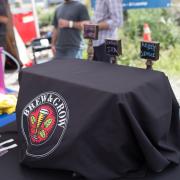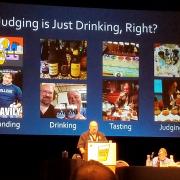I've been doing some thinking (and researching) and have decided I want to convert a 1/2 bbl keg into an electric boil kettle. I figure the keg is $30 at most, the stuff to cut it out is at the brew house and most of the equipment needed is pretty easy to come by and not terribly expensive.
That said, all I am looking to do is simply add two 120v elements to a keggle with a power knob (I know there is a technical term for it) for each element. I'm NOT looking to automate this, add sight glass, thermometer, false bottom, even a valve. All I want right now is a basic, primitive boil kettle that I can use at home. Looks like the elements are no more than $15 each depending on where you get them and the wiring I can do myself.
Here is the questions start. I know Dave is looking to build an electric brew system and some others may have already done this so I ask you, what all am I going to need? What is it going to take to bring 10 gallons of wort to a boil in a keggle with electric heating elements?
Start the discussion!










Dave, let me know when you plan on putting some of this together. I've been doing a lot of research and what I want to do right now is install a 30amp GFI breaker in my box, wire up a small, cheap "control panel" that will hold a PWM and SSR, and then wire it to a 5500watt element. The part I'm not sure of is basically the PWM. There is a lot of talk online about building your own and purchased ones usually have to be modified. Anyway, if you have some knowledge of these things I would love to chat about it.
I've been doing research for a long time...and am planning on putting a full electric system into the brew house. If your willing to wait...I plan on putting the system together soon. I have most of the parts...but am short on things like a pump and control enclosure.
To be honest, what you described above sounds like you could do it on the cheap...but it wouldn't be that safe. if you are doing 240v, (or even 120v to be honest) in a wet environment with the possibility of electrifying a metal kettle, you def want a GFCI breaker. Last thing you want is pass current through your kettle...especially high voltage.
The system I am working on will run off of a GFCI breaker. Any imbalance in current will trip the breaker and shut everything down. The setup is 240v using a 5500 watt ULD element. For control I will be using a PID with SSR and heatsink. I tossed around the idea of using a BCS 460 controller....because the interface is nice...but I already have the PID so will most likely go that route.
This last week, I cut holes (with the help of Ed and his jig) into two kegs. I already have one that I use as a boil kettle. The system will be a single tier 3 vessel all controlled, most likely, by PID. I will also be plumbing everything for bottom drain.
Don't they have those drop in elements that you just plug in? I think I saw them in at Brew and grow...
Bill is right...just wire one straight in....that would be the cheapest way....
Oh and I would for sure put a valve in...there is no way your gonna left a keg with 10 gallons of wort in it...plus it is hot, and the lip on the keg makes a mess...
Amazon has a bunch of different models with varying resistance... I was thinking one for each element and buy a plastic knob.
I think my biggest question at this point is whether I can take apart my breaker board and wire in a 240v, 50amp plug just for brewing. This is what will determine how I go about this as a 240 is much better than 120. I've been looking online but haven't really found any answers and seeing as how I don't know much about electricity I'm not going to go poking around in there.
And the fuse box in my apartment has two 50amp fuses that act as the master power in my place. I'm assuming it's 240v coming out of that. Is there a way I can tap into that?
From what I gather all I need to do is secure the elements to the kettle via silicone gaskets, runs the proper gauge wire to a potentiometer, and run the potentiometer to a plug. Am I missing anything besides making sure it is all grounded and waterproof?
He is using digital PID's in a control box... much more than what I want to do right now. I'm looking to go cheap and primitive.
Here is a link as well, this page really shows all I want to do which is put an element in the kettle, and attach a potentiometer somewhere along the line. This guy has some good write-ups.
http://theelectricbrewery.com/heating-elements?page=7
It's not confusing, these are all things I've looked into. I don't have 240v in my place so I will be using 2 120v which I think means I have to get high density. The research I have done, however, says that high density works fine with wort, no scorching of any kind.
Could you explain "closed loop" a little more. The dial I was thinking of is, I think, a potentiometer.
I think if you know the dynamics of the system you can build one, however if you don't know how you can consult the experts. One thing I ask about this electric brewer kettle is, if ever i have to buy this in the retailer can we buy this in an less expensive one. The next question can we expect for a good taste and result from any other brewery. Thanks guy for the post.
http://www.timmccallan.net/
This is my first post here, but I came by for your Fall session and met a few guys. In any case, I design and build sophisticated pollution analyzers with super tight temp control and electric valving for a living. Enough with my back story, but you really can't use a potentiometer to control a 240VAC or even a 120VAC circuit. You can use a dimmer switch, like some people have installed in their bedrooms (for when SWMBO wants to get frisky), but they are usually not rated for the amperage that these elements demand and good luck finding one for 240VAC. Your best bet is a PID with SSR like the one that theelectricbrewery.com is explaining.
The "high density" refers to how long the actual resistance element is and whether or not it is bent back on itself 1 or more times to achieve greater surface area with the same heating power. When guys on HBT talk about an Ultra High Density element, they mean one that is super long and bent back on itself sometimes 3-4 times. These are great for electric brewing because the surface area is way higher than an element bent back on itself only once or twice and with the same power rating, the Watts/Sq. in. is low enough to keep your wort from scorching.
For those without a dedicated 240V outlet circuit (i.e. apt dwellers like myself), there is a way to mimic 240V. You need to first find two 120VAC outlets with GFCI (we're dealing with water people) and they need to be on separate circuit breakers on your building's power panel. Most modern kitchens will have GFCI's on all their outlets and typically they will only put 2-4 duplex outlets on each circuit breaker because of the higher potential current draw of common household kitchen appliances vs. the common standard of between 4-8 duplex outlets on each circuit breaker as is commonly found in other areas of a house. So if your kitchen is modern and has greater than 2-4 outlets in it, chances are you have what you need to make 240VAC power. Next thing to do is wire into your electric kettle with a cord plugged into each of those separate circuited outlets and then use the hot (usually black) lead from each and one of the grounds to make 240VAC and ignore the extra ground and the two neutrals. 240VAC is just that, two hots and a ground as opposed to 120VAC, which is one hot, one neutral and one ground.
As part of the rollout of the new Brewhouse i'm hoping to at least get one or two bays with 220/240 wired up so we don't have to do any cheating :-)
If you know a lot about electric, we'd love the help. Dave, Adam, and I are usually the ones who do the electric but we're certainly not experts. We're meeting at the new brewhouse tomorrow evening at 7:30. Here's the event posting if you'd like to come by! http://www.chaosbrewclub.net/event/brewhouse-20-project-meeting.
Oh... my... god. Why haven't we done this? http://thechive.com/2013/09/17/guys-rig-up-buddies-plumbing-with-beer-wh...
Ya, I'll try and make an appearance. Like I said, my day job is to design circuits in a myriad of voltages (5VDC, 24VDC, 120VAC, 240VAC, and even 600VAC) and with much more advanced equipment than your run of the mill Love and Ranco temperature controllers that homebrewers use. We have PIDs that are capable of keeping our samples within 0.1 degree F of a setpoint in order for us to meet the EPA requirements for the pollution measurement. I have designed a built a couple of stand alone temp. controllers that are portable and can be used for various brewing related projects. Right now, I have one controlling my kegerator (until I build a permanent solution) and another is controlling a heat mat I was using for a sour mash Berlinner Weiss. I'll try and bring by a couple of my electric controllers for you guys to take a gander at my skills, but in any case, here's a couple pics for you to drool over.
https://www.dropbox.com/sh/4y09fj1pcj7wzpk/M4zLq8_1us
That's incredible. We have our ferm room, lager freezer, and hot box controlled by some of these guys (or variations of) http://www.ebay.com/itm/110v-AC-All-purpose-Temperature-Controller-STC-1...
For most of my personal projects I've just used thermocouples or occasionally an RTD, how the heck do you all ready the temp sufficiently to keep it at 0.1 def F? I bet there's a ton of math involved in PWMing the various elements....
Oh... my... god. Why haven't we done this? http://thechive.com/2013/09/17/guys-rig-up-buddies-plumbing-with-beer-wh...